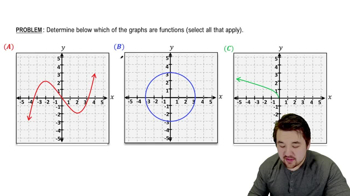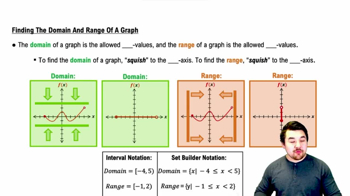Table of contents
- 0. Functions7h 52m
- Introduction to Functions16m
- Piecewise Functions10m
- Properties of Functions9m
- Common Functions1h 8m
- Transformations5m
- Combining Functions27m
- Exponent rules32m
- Exponential Functions28m
- Logarithmic Functions24m
- Properties of Logarithms34m
- Exponential & Logarithmic Equations35m
- Introduction to Trigonometric Functions38m
- Graphs of Trigonometric Functions44m
- Trigonometric Identities47m
- Inverse Trigonometric Functions48m
- 1. Limits and Continuity2h 2m
- 2. Intro to Derivatives1h 33m
- 3. Techniques of Differentiation3h 18m
- 4. Applications of Derivatives2h 38m
- 5. Graphical Applications of Derivatives6h 2m
- 6. Derivatives of Inverse, Exponential, & Logarithmic Functions2h 37m
- 7. Antiderivatives & Indefinite Integrals1h 26m
0. Functions
Introduction to Functions
Problem 3
Textbook Question
Decide whether f, g, or both represent one-to-one functions. <IMAGE>
 Verified step by step guidance
Verified step by step guidance1
Understand the definition of a one-to-one function: A function is one-to-one if and only if every element of the function's range is mapped to by exactly one element of its domain. This means that no two different inputs should produce the same output.
To determine if a function is one-to-one, you can use the Horizontal Line Test. If any horizontal line intersects the graph of the function more than once, the function is not one-to-one.
Examine the graph of function f. Check if there are any horizontal lines that intersect the graph at more than one point. If such lines exist, f is not one-to-one.
Examine the graph of function g. Similarly, check for horizontal lines that intersect the graph at more than one point. If such lines exist, g is not one-to-one.
Conclude based on your observations: If neither graph is intersected more than once by any horizontal line, both functions are one-to-one. If only one graph passes the test, only that function is one-to-one. If both fail, neither is one-to-one.
Recommended similar problem, with video answer:
 Verified Solution
Verified SolutionThis video solution was recommended by our tutors as helpful for the problem above
Video duration:
2mPlay a video:
Was this helpful?

 1:36m
1:36mWatch next
Master Introduction to Calculus Channel with a bite sized video explanation from Callie
Start learning





